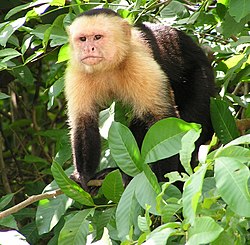Portal:Primates
The Primates Portal A primate is a member of the biological order Primates, the group that contains lemurs, the aye-aye, lorisids, galagos, tarsiers, monkeys, and apes, with the last category including great apes. With the exception of humans, who inhabit every continent on Earth, most primates live in tropical or subtropical regions of the Americas, Africa and Asia. Primates range in size from the 30-gram (1 oz) pygmy mouse lemur to the 200-kilogram (440 lb) mountain gorilla. According to fossil evidence, the primitive ancestors of primates may have existed in the late Cretaceous period around 65 mya (million years ago), and the oldest known primate is the Late Paleocene Plesiadapis, c. 55–58 mya. Molecular clock studies suggest that the primate branch may be even older, originating in the mid-Cretaceous period around 85 mya. Primates exhibit a wide range of characteristics. Some primates do not live primarily in trees, but all species possess adaptations for climbing trees. Locomotion techniques used include leaping from tree to tree, walking on two or four limbs, knuckle-walking, and swinging between branches of trees (known as brachiation). Primates are characterized by their large brains relative to other mammals. These features are most significant in monkeys and apes, and noticeably less so in lorises and lemurs. Many species are sexually dimorphic, which means males and females have different physical traits, including body mass, canine tooth size, and coloration.
Selected article
Slow lorises (genus Nycticebus) are strepsirrhine primates found in South and Southeast Asia. They range from Northeast India to the southern Philippines and from the Yunnan province in China in the north to the island of Java in the south. There are currently five species recognized: Sunda slow loris (N. coucang), Bengal slow loris (N. bengalensis), pygmy slow loris (N. pygmaeus), Javan slow loris (N. javanicus), and the Bornean slow loris (N. menagensis). Slow lorises are most closely related to other lorisids, such as slender lorises, pottos, the false potto, and angwantibos.
Like other living ("crown") strepsirrhines, these nocturnal primates have a reflective layer in their eye called the tapetum lucidum, which enhances their night vision. They also have a rhinarium or "wet nose", which is a touch-based sense organ. Because of their close relation to lemurs and other lorisiforms, they also possess a toothcomb, which is used in personal and social grooming, as well as feeding. Like nearly all prosimian ("pre-monkey") primates, they have a toilet-claw, which is also used in grooming. Slow lorises have a round head, narrow snout, large eyes, and distinctive coloration patterns. Their arms and legs are nearly equal in length, and their trunk is long, allowing them to twist and extend to nearby branches. The hands and feet of slow lorises have several adaptations that give them a pincer-like grip and enable them to grasp branches for long periods of time. Slow lorises and possibly some of their closest relatives have a toxic bite—a rare trait among mammals. Little is known about their social structure, but they are known to communicate by scent-marking. Males are highly territorial. Slow lorises reproduce slowly, and the infants are initially parked on branches or carried by either parent. They are omnivores, eating small animals, fruit, tree gum, and other vegetation. All slow loris species are listed as either "Vulnerable" or "Endangered" on the International Union for Conservation of Nature and Natural Resources Red List of Threatened Species (IUCN Red List) and are threatened by the wildlife trade and habitat loss. Although their habitat is rapidly disappearing and becoming fragmented, making it nearly impossible for slow lorises to disperse between forest fragments, unsustainable demand from the exotic pet trade and traditional medicine has been the greatest cause for their decline. Selected picture A Barbary macaque (Macaca sylvanus) by the Upper Rock Nature Reserve in Gibraltar. Although the species is commonly referred to as the "Barbary ape", it is in fact a monkey. The Barbary macaque population in Gibraltar is the last in the whole of the European continent. A popular belief holds that as long as Barbary macaques exist on Gibraltar, the territory will remain under British rule. CategoriesSelected species Least Concern (IUCN 3.1)|Least Concern The white-headed capuchin (Cebus capucinus), also known as the white-faced capuchin or white-throated capuchin, is a medium-sized New World monkey of the family Cebidae, subfamily Cebinae. Native to the forests of Central America and the extreme north-western portion of South America, the white-headed capuchin is important to rainforest ecology for its role in dispersing seeds and pollen. Among the best known monkeys, the white-headed capuchin is recognized as the typical companion to the organ grinder. In recent years the species has become popular in North American media. It is a highly intelligent monkey and has been trained to assist paraplegic persons. It is a medium-sized monkey, weighing up to 3.9 kg (8.6 lb). It is mostly black, but with a pink face and white on much of the front part of the body, giving it its common name. It has a distinctive prehensile tail that is often carried coiled up and is used to help support the monkey when it is feeding beneath a branch. Did you know?
Primate lists
WikiProjectsThings to do
Associated WikimediaDiscover Wikipedia using portals |

















